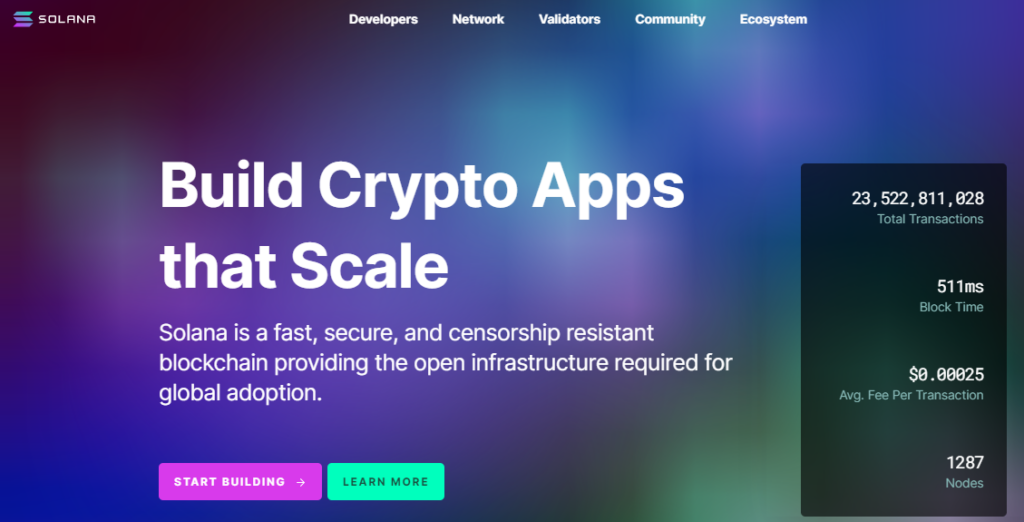Ever since Ethereum pioneered the concept of a blockchain enabling the creation of decentralized applications (or dApps) and smart contracts, plenty of projects have come forth with their own versions of this vision.
This list includes the likes of Cardano, Polkadot, and Solana, the latter of which is tackling this objective in a uniquely ambitious way. In Solana’s whitepaper, the founder, Anatoly Yakovenko, describes the concept as a ‘new architecture for a high-performance blockchain.’

Despite work on the project beginning as early as 2017, Solana only officially came into the public sphere in March 2020 as a product of the Swiss-based Solana Foundation.
To many’s delights, the cryptocurrency has seen impressive gains within this relatively short span as it’s currently ranked 14th for most traded and dominates 0.56% of the entire market cap, according to CoinGecko.
Since launching in March 2020, the coin had seen a staggering 5800% increase when it reached an all-time high of $58.03 in May 2021. Presently, it is valued at around $38.44. So, how does Solana work, and what is so special about it? Let’s discover more.
So, what is Solana?
Solana describes itself as a platform for building crypto apps that scale, which is presently one of crypto’s greatest challenges. More technically, it is a third-generation blockchain for building decentralized applications and smart contracts securely, quickly, and with the most advanced scalability.
dApps are merely blockchain-powered computerized programs operating without any centralized systems and controls. A smart contract is a coded contract built to execute by itself when particular conditions have been met.
Like most cryptocurrencies, Solana utilizes its native token, SOL, as the ‘fuel’ for much of the operations on the network. Being partly a proof-of-stake (PoS) consensus mechanism means holders of SOL earn rewards from staking their coins on Solana through powering and supporting the blockchain.
In addition, having the SOL stake allows for the compensation of transaction fees and a say in future governance protocols.
Technically, however, Solana is a hybrid consensus mechanism, with the other being something known as proof-of-history (PoH) that is uniquely integral to the tremendous scalability the project achieves compared to its counterparts.
We will explore this part of Solana in more depth within the next section.
Solana’s proof-of-history system
The proof-of-history mechanism deals with regulating the time of a transaction. In the traditional proof-of-work method for the likes of Bitcoin, each block contains an individual timestamp, which a single computer validates in unison or consensus with others.
Although this process adds a layer of verification, it consequently takes up a bit of time, partly contributing to why such a consensus mechanism is slow. So, how does Solana’s PoH differ from this conventional approach?
With proof of work, each miner adds a timestamp according to their clock, which requires further validation from the other peers on the network in case it’s different or false. Solana relies on a single global source of time or ‘synchronized clock,’ allowing a vast reduction in how long future blocks form.
What’s worth mentioning is PoH isn’t a consensus mechanism; it’s merely a method of reducing the time spent in validating transactions. Another innovation with Solana is forwarding new transactions even when previous ones haven’t been finalized yet, another contributor to maximizing the confirmation speed.
If we couple this factor with proof-of-stake, which is inherently faster than proof-of-work, it’s clear how Solana achieves incredible scalability across the board.
A brief history of Solana
Anatoly Yakovenko, the ex-Qualcomm, and ex-Dropbox software engineer, are credited with the creation of Solana. Yakovenko spent several years at these corporations before leaving to build Solana in 2017.
According to a May 2021 TechCrunch interview, the software engineer describes the concept of proof of history as having the goal to make the Solana network move at the speed of light.
Yakovenko recognized the problem in the amount of time more established cryptocurrencies such as Bitcoin took to confirm transfers.
Instead of miners deciding the sequence of how the transactions are confirmed, Solana’s blockchain performs this process automatically, allowing for better security and censorship resistance.
The initial introduction of Solana came at the perfect time during the ICO (initial coin offering) boom of 2017, managing to raise a reported $25 million in several rounds of public and private funding.
It could be said Yakovenko was operating primarily as a one-man band at this time. Fortunately, the American eventually teamed up with his ex Qualcomm colleague, Greg Fitzgerald, who was principally responsible for much of the programming for Solana.
After the project’s whitepaper and several testnet phases were in the public domain from February 2018, the finished product for Solana came to light in March 2020.
Why is Solana valuable?
Understanding what makes Solana special needs an observation into how more popular blockchains are processing transactions. Despite being the two leading names in the space, Bitcoin and Ethereum are tremendously hindered in scaling, particularly with the latter facilitating hundreds of different types of applications at once.
Among other reasons, the primary driver is the consensus mechanism behind both coins with high fees and delays when their respective networks become congested.
It is one of the motivations behind the proof-of-stake system, which produces astronomically greater scalability. As a quick comparison, Bitcoin processes about seven tps (transaction per second), Ethereum does around 12, and Solana handles at least 50 000 tps with 400ms block times.
Overall, Solana excels tremendously in scalability, low costs, and interoperability, all necessary features for blockchain technology to be more widely used in the near future. Moreover, Solana seeks to maintain these immense qualities without trading off on decentralization and security.
Final word
With close to 1300 nodes and more than 40 dApps fueled by Solana, this project is ideally poised for more potential growth in the future. Currently, the most prominent sectors within cryptocurrencies are smart contracts and dApps, both of which Solana includes in their network.
Solana will continue to move forward in the quest of being a substantial technological leap within blockchain technology and inspire a myriad of other cryptocurrencies to fulfill the same vision.






